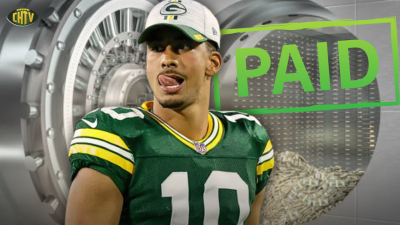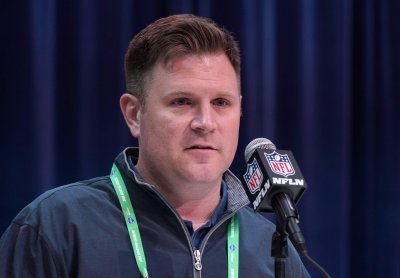Crosby's Par-5 Kicks Need Adjustments
Mason Crosby would be advised to learn a lesson from the game of golf to improve his mechanics on long field goals.
By tundravision
I've never been much of a golfer, but at one point in my life, I got to the point where I could hold my own with a pretty generous handicap from my more talented brethren. Golfing a few times a month, I finally got past the point where I stopped swinging at the ball like I was swinging a baseball bat or a hockey stick. Instead of spraying the ball every which way (and usually not past the ladies' tees on the drive), I developed a rudimentary approach common to many beginners. You know, the stiff, robotic swing with the ball leaving the tee in a high-arching loop. Not much for distance, but at least I kept the ball in the fairway and gave myself a fighting chance to avoid a bogey.
As my confidence grew, I found myself jealous of my buddy, a lifelong golfer, who seemed to effortlessly stroke the ball for monstrous distances. Of course, he was highly motivated to make up the 20-30 stroke difference in our handicaps, so he certainly wasn't taking it easy on me. While I would be lucky to make it onto a par-5 green in four strokes, he was regularly shooting to make it on in two.
So, one day, I decide I'm going to try and match him. I'm not a little guy. I have broad shoulders and can easily generate the power needed to smash the ball a lot farther than I've been doing so far. I mean, all I have to do is hit the ball harder, and just keep up the approach that I've pretty much mastered. Right?
So, I line it up, set my feet, and take my practice swings. My buddy offers me a few tips, but I'm not listening. I've got this. I move up, and lift my club up to maximum position, almost holding it there for an instant as I shift my energy to bring it down with power.
I'm bringing the club down, and in slow-motion, I'm acutely aware of every muscle twitch in my body. The first thing I feel is that graceful, almost-perfect circle route my club usually takes being skewed by my extra power. I'm bringing the club into the ball on a flatter arc, designed to generate more power, more straight-ahead speed. I adjust mid-flight to make sure the head of the club is still on target to hit the ball.
But somewhere else along the way, I feel it. Something is out of place. Maybe its somewhere in my back, or the front of my legs. It's definitely somewhere in my wrists, focused more on pulling that club along with due force, instead of stiffly riding it through the motion. My eyes flit off of the ball, ever so slightly, as I feel the club make contact.
For an instant, the ball sprays off the tee just as I want it to, reminiscent of my buddy's near flat trajectory, the one that slowly elevates high into the air in a majestic ascent towards the green, still rising when it passes my ball lying in the fairway. It certainly has the power: I nailed it. But just at the same moment when it should start rising, it takes a slow turn to the right. Yes, it rises, but every inch it rises, it careens another degree off target.
By the time the ball has reached its apex, it's heading straight for the adjacent fairway. I lower my head and realize that had I just hit the ball with my usual power, and my trusty approach, I'd be a heck of a lot closer to the green than I am now. Double bogey.
------------------
I tell this story because I think it has a lot to do with the problems Mason Crosby has this season with the long-distance field goals. No, we shouldn't expect Crosby to hit every single 50+ yarder. But we also shouldn't expect the misses to be caught by fans sitting on the ten-yard line, either.
Obviously, he's not a neophyte like I was at golf. He's a pro that's been kicking his whole life and came into the league with a reputation as a power kicker. The dude is kicking 100% of his extra points (20/20) this season, and 100% of his field goals under 50 yards (7/7). As soon as you go above 50 yards, though, he falls to 25% (1/4), and results aren't pretty.
The 50-yard field goal is kicked much differently than an extra point or a 27-yard field goal, either of which can be struck low and sent into a high arc that easily sails over defenders heads. Notice you rarely, if ever, see a defender get a hand on the ball of an extra point once it reaches the line of scrimmage. That's because it's a good 5-10 feet above them.
But a long field goal requires distance. It is hit at a lower trajectory to increase the distance, thus at a greater risk of being blocked. It's often hit with a little more power, too...the natural human reaction to kicking something longer than we're used to. It's an interesting conundrum, because how often do we see Crosby kick a 45-yarder that would have been good from 55-yards, but he can't seem to kick it through when it is actually from 55-yards?
Crosby's long kicks aren't just barely missing. They're slicing. Or fading, something I was an inadvertent expert at in golf. Like my attempts at power strokes, they're flying away from the goalposts as if repelled by some superpowered magnet with the same polarity as the football.
What makes the discussion more interesting is how well Crosby kicked the onside kick yesterday, an arching squib kick that McCarthy praised in his post-game presser as the highest he's ever seen a kicker reach. Again, think about how well Crosby has become at low-impact, high-arching kicks. He had no problem adjusting to the onside kick when it didn't involve power, just height.
And just like his final miss against the Colts, Crosby could tell his timing was off on his approach on yesterday's missed 58-yarder. The timing has to be so perfect on those long kicks, he said. Yet, why isn't timing an issue on the 27 extra points and short field goals he's made this season?
My diagnosis, based purely on my own experiences at golf, would be that Crosby simply is not adapting his mechanics properly for swinging his foot more through the ball, at a lower trajectory. It's really not that hard to do, but it something that can get inside your head if you start overcompensating and trying to fix it without really knowing what the problem is.
In a way, you have to swing in a completely different way to hit the ball lower, and with more power. If you're in a kicking motion that you can reliably make field goals from short-range, but keep mis-striking the ball on long-range kicks, that striking motion isn't working
It might mean that Crosby has to modify his kicking mechanics so that he's doing the same motions on a long or short field goal attempt. This, of course, is full of inherent dangers, especially considering some of the mid-season mechanic experiments that Shawn Slocum has already screwed up in the past.
The other option is for Crosby to begin diversifying his kicking mechanics, having a seperate approach for his short kicks and long kicks. This also has some dangers. It could backfire.
But, on the other hand, Crosby is a well-compensated professional. And we seem to never face a team this season that doesn't have a kicker that can kick 50+ yarders with ease. It shouldn't be that hard.
But then, that's what my buddy kept telling me about golf, too.













Comments (2)
October 22, 2012 at 08:10 pm
I'm glad you touched on this subject because if I heard correctly, Crosby actually kicks on the top half of the ball on long kicks. Don't know if this is true, but it seems counterintuitive. It would explain why the ball knuckles if he miss hits it, instead of going end over end (and straighter) when you connect from the bottom.
Wonder if there are any kicking gurus out there who advocate this technique. Or did I hear this incorrectly? Seems like Crosby would have enough leg strength to hit fifty plus yarders by hitting under the ball. Also, wonder why he likes the ball tilted nearly straight-up.
Anyway, I'll be in another room from where the broadcast is if Crosby is lining up a 50+ yarder with the season on the line. Or the concourse if I'm at the game. Couldn't watch.
October 23, 2012 at 08:41 am
I can always tell how a kicker is kicking by watching his extra points. Do they go straight down the middle or are they a little off. Are they low or high. Watching Greg the leg (Rams) his extra points were both high and down the middle last week. Crosby's are low and off the mark. I wouldn't want to rely on him at this point. Kickers seem to go in and out of the zone. Crosby is currently out of the zone. Hopefully he'll get back in. I remember when Longwell went out of the zone for a while. He adjusted and got back in. Watch the extra points. That's where you can tell how they are kicking.